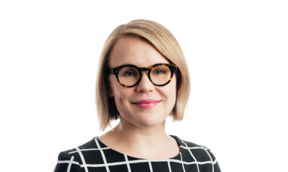Breaking boundaries – the power of multidisciplinarity

Complex problems require multidisciplinary solutions
The world is wild, difficult to forecast, and not arranged according to the precise boundaries of our academic disciplines. Take, for example, our most pressing problem, global warming. To fight it, we need an understanding of the climate, built and natural environments, social and political processes, energy production, food industry, materials, and economy, to name a few.
Any megatrend-size problem is multifaceted, and no discipline is going to solve any of them alone. That is why we need cooperation and bridging gaps between professions and areas of expertise. The same goes for smaller challenges in daily working lives. Bringing students from different disciplines together to solve real-life problems helps them get a much fuller picture of the surrounding world – and solve the complex challenges no matter the size.
Learning to utilize all strengths in a team
Real-life teams are often multidisciplinary. Learning to utilize different strengths of different people is a valuable teamworking skill. That’s why it is good to give students a head start to interdisciplinary cooperation during their studies. Understanding and appreciating other people’s viewpoints help students broaden their thinking and produce more creative solutions.
Figuring out strengths by working together
When students are surrounded by people studying the same things, it is sometimes hard for them to see what they can bring to a team that is unique and not to be taken for granted. Sometimes this leads to an identity struggle and difficulties translating their education to marketable skills for potential employers.
Crossing paths and working on real problems with students of other disciplines can help students figure out what kind of competence and viewpoints are unique to their academic background. Seeing what others bring to the table, it is easier for students to see their role and strengths as a team member. Multidisciplinary cooperation, combined with the reflection of each team member’s roles and strengths, can help students a long way to discovering their professional identity and confidence.
Ahead: a career full of learning
The world in which today’s students will work will inevitably change radically during their careers. No matter what they chose to study originally, this education will unlikely carry them to the end of their careers. Societies, businesses, and jobs change. So, everyone is required to change too and steer their skills in a way more suited to the changing environment.
That could mean small tweaks or bigger career shifts, but none the less stepping outside the comfort zone and gaining new skills and knowledge from other disciplines as well. So to help students flex their multidisciplinary muscles early on, we need to create situations for them to work, collaborate, discuss, compare and reflect with students of other disciplines – and to break boundaries together.
Author:
Piritta Jokelainen
Piritta Jokelainen is a senior advocacy specialist at Yhteiskunta-alan korkeakoulutetut (Social Science professionals). She is focused on education policy and wants to promote the joy of cooperation and lifelong learning in the field of higher education.
- Published:
- Updated:
Read more news

HRH Princess Maha Chakri Sirindhorn of Thailand visited Aalto University
During the visit, HRH and her delegation met with Aalto students and explored various activities.
Campus for people, plants and pollinators
The Otaniemi campus nature is managed with respect to biodiversity and the characteristic species of habitats.
Online AI course could boost study equality
Students at the School of Business believe that mastering Artificial Intelligence (AI) can be beneficial for both academic success and career prospects, as AI becomes increasingly integrated into daily life.